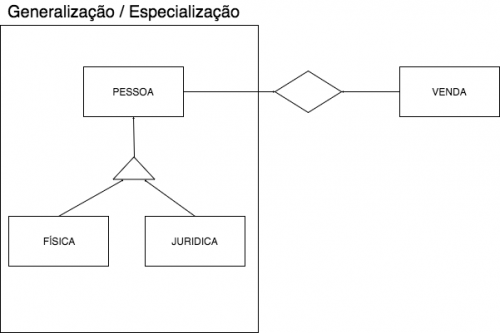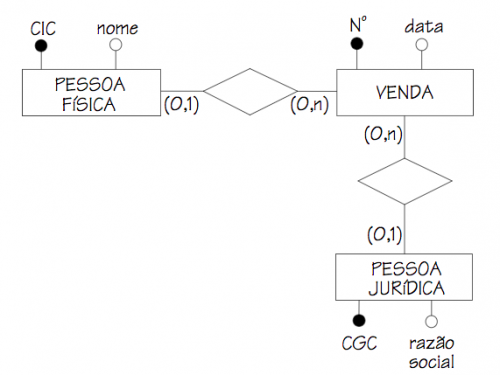Mutually exclusive relationship (MER)
I know there are several ways to implement this conceptual model, but I would like to know the best way (if there is one that stands out)
Legend
PK: Primary Key;
FK: Foreign Key
See an example of a unique relationship
Taken from transparency of this book
Among the various forms of implement would like to highlight 2
The first form
Consider using generalization/specialization in this same example, drawing like this: 
Now imagine that the entities of the relational model will become tables of the logical project, and the PK of the table Person will be referenced as FK in the table JURIDICO, and so it will occur with the other "daughter"tables.
Second Form
Similar to the first but with inversion in the keys, now the PK key of the legal Table will be referenced in the Table Person as an FK and so on.
Important comments to consider
Notice that the entity sale needs is related as a legal entity or a natural person and it is not possible to compose a record with both at the same time.
Notice that if entity Person is deleted then entity sell would be composed of 2 foreign keys being the first "CPF" FK referencing the id of the table Physica and the second key "CNPJ" FK referencing the id of the table JURIDICA.
It seems to me that doing the above form generates is an inconsistency error, because these two FKS must be declared as optional, i.e. can be null.
This problem just to be solved at the application level? or to solve this inconsistency at the project level conceptual?
In this link you can see another example about mutually exclusive relationship
1 answers
"foreign key" multiplexing
Each form has its advantages and disadvantages, obviously. Decide which is the best I believe you should do in your application, provided you have knowledge base to be able to make that choice decision. I will present a recent case that I passed in the company.
I work in a sales system, one of our features is that the seller has a current account. Thus, if the seller wants to give a discount more than the limit certain product, it consumes this current account and closes the sale.
Such a request may By Chance be pending, so the figure of the supervisor enters. The supervisor roughly approves or disapproves of orders placed by sellers. In addition, in case the supervisor wants to make it easier for a seller to close a last-minute purchase, he can make a transfer from his current account to the seller's current account.
Both supervisor and seller are users of the system.
That said, the modeling is very similar image of generalization/specialization that you put. I have the Table USUARIO, CONTACORRENTE (yes, it was alljoint the original name of this table) with non-null foreign key for USUARIO, VENDEDOR with non-null foreign key for USUARIO and SUPERVISOR with non-null foreign key for USUARIO. SUPERVISOR and VENDEDOR also have their own codes that have no relation to the user code.
Well, everything was quiet until the following customization arrived:
The buyer (in our system called
CLIENTE) can also have a current account. In compensation you cannot require that this client has user
My first reaction was to propose creating artificial users to keep this relationship intact. Can I say that she was not at all well accepted? It had to do with business requirements because we sell user to use the system and this my idea would mess up cool this control.
Okay, next alternative? Multiplex the foreign key.
Yes, bizarre, but practical. Solved our modeling problems. We proposed a migration of such luck that operations made in the old CONTACORRENTE (now transformed into view) affected only the image migrated in the table new CONTA_CORRENTE (yes, we are creative :+1:).
It is worth saying that we erred in migration trigger what would do this magic? We forgot to test inserts in batch, which generates crazy inconsistencies... but obviously we fixed this error" tested " in production
Multiplexing works as follows:
- I have a column that will be the "logical foreign key"of some table;
- I have another column that simply indicates which table the first column points to.
The idea came from wavelength-based multiplexing of the MPλS , where through the intrinsic properties of data transmission in optical fibers the system knows which destination to direct.
The parallel between light waves and table rows then stood:
- both have multiplexer attributes (wavelength/multiplexer column);
- both load data that differs from the differentiating attribute (amplitude and phase of the wave/the other columns of the tuple).
In general, the multiplexing I used to represent this relationship can be understood through the following scheme:
![[table multiplexing]](/images/content/251091/5ef5fe2ad6df7e9fdbcfe6d530187662.png)
The Triangle is not a real entity, it is just the "point" where multiplexing occurs.
Generally speaking, we work with databases of occasional integrity. It makes several operations in SQL-Server easier and we have the advantage that we can have temporary inconsistent States (but not like the that the SQLite allows), so we don't worry about putting literal FOREIGN KEY and CHECK CONSTRAINTS tries in the bank. We leave it up to those who will populate the data to do this in a coherent way.
This was a real solution to a problem that happened. I'm not going to say that every problem of this kind you should go this way. Nor will I say to always run away from such a solution. Knowledge is power, use it wisely and thrift.
Multiple foreign keys (aka question Mode 1)
This type of binding can cause problems, especially if it is deliberately chosen in project creation to avoid certain types of constraints to avoid overheads (1 e 2).
I have a pesquisa that a vendedor will apply to clientes that meet certain conditions. In this case, the conditions can be:
- customers who buy certain representations (for example, those who buy Herbalife)
- customers belonging to the particular route of the seller
- all customers of that seller
- question applicable to sellers under the supervision of a particular supervisor
- all customers of all sellers without exception
This can be modeled as follows:
APLICAÇÃO_PESQUISA:
- CD_PESQUISA
- CD_REPRESENTAÇÃO
- CD_SUPERVISOR
- CD_VENDEDOR
- CD_SUPERVISOR
For the sake of speed for the latter case, a additional flag , a identifier of all , thus being the final structure:
APLICAÇÃO_PESQUISA:
- CD_PESQUISA
- CD_REPRESENTAÇÃO
- CD_SUPERVISOR
- CD_VENDEDOR
- CD_SUPERVISOR
- ID_TODOS
For the sake of avoiding overheads, it does not have the constraint where only one of these values can be non-null.
Well, due to this" loose restriction " very dependent on registration (and, even worse, if this information is imported from an external system, we don't have too much control over it). So what happens to who will consume this information?
At the beginning of the conversation, these constraints are not formally documented anywhere, so the poor soul who will take the scheme and try to extract some meaning from it will take into account that any subset can happen. Except ID_TODOS marked as true and someone not null, this can not.
So it turns out that the poor soul who made this query, out of ignorance, had to take into account:
- if there is a representation of that seller and the customer at the same time, but the customer is not served by that seller in that representation, is the search application valid for that seller and that customer?
- and if it is marked a seller and a supervisor who is not part of your supervisor chain nor the supervisors of your supervisor, should I treat it as a kind of
OUor is the data invalid?
Multiple foreign keys, the most specific
Has cases in which one really wants that multiple foreign keys can connect or not to a certain structure, by design even purposeful. I will not go too far into the merit here of the structure and its foreign keys.
Imagine you have 7 foreign keys. CE0, CE1, CE2, CE3, CE4, CE5 and CE6. There are 27-1=127 distinct ways that such a marriage can occur. So, how to decide which ways more specific?
We can say that each row of this table has an Associated "bitrate". We can represent as a 7-bit number as follows:
- if the column
CE_iis non-null, the position bitiis worth1 - if column
CE_iis null, the position bitiis worth0
Then the "artifical column" bitagem can present the value 0110111 (little endian ), which means:
-
0for columnCE0, hence null -
1for columnCE1, so not null -
1for columnCE2, so not null -
0for columnCE3, therefore null -
1for columnCE4, so not null -
1for columnCE5, so not null -
1for columnCE6, so not null
For a value of 64+32+16+4+2 = 118
On this bitagem, we can define an auxiliary table that associates bitagem with an arbitrary prioridade, and can then make any desired ordering as the "most specific".
Although this formulation recalls taxonomy 1, as it allows making multiple connections at the same time, it does not fit into this category.
